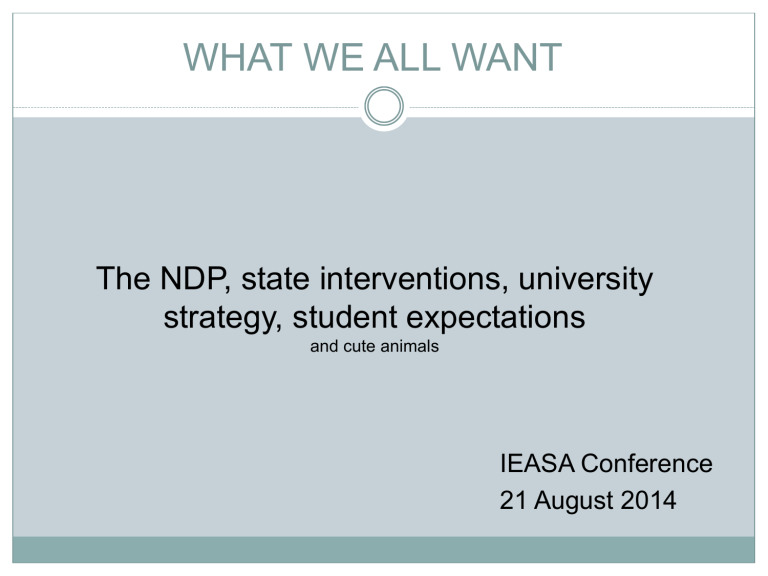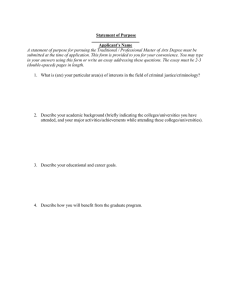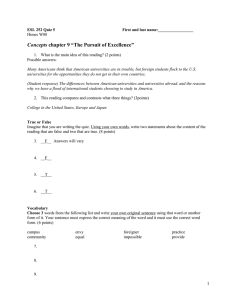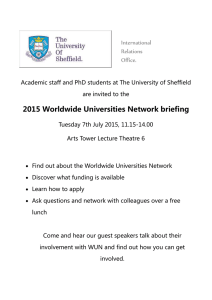
WHAT WE ALL WANT The NDP, state interventions, university strategy, student expectations and cute animals IEASA Conference 21 August 2014 Size & Shape of universities 25 institutions: 13 universities, 6 UOT’s, 6 comprehensives 2 National Institutes – Mpumalanga & Northern Cape Student enrolments increased from 553 839 in 1999 to 978 548 in 2013 53 public TVET Colleges with 657 690 students 92 Private institutions – 93,000 ‘Missing’ 250,000 students in short courses – not recognised by SAQA: Microsoft, SAP, TEFL In 2012, 165 000 graduates and diplomats were delivered to the country 72 859 international students ‘at’ our institutions in 2012 Some Trends • From state steering to co-operation (Pandor period) to state steering • Post 2005 – focus shifted towards schooling, ABET and TVET Colleges Changing agenda • Massification of the sector • 1 more university, 12 more colleges (2015) • Community colleges (1 million ABET absorbed) • From critical citizens to skilled HRD Cute Animal Research Study [2012, 2014] “This finding suggests that viewing cute images makes participants behave more deliberately, focus more attentively and perform tasks with greater time and care” National Development Plan: Role of Higher Education The affirmation of the critical role of higher education in the development of SA by the National Development Plan 2030 (NPC, 2012) was very re-assuring. The Plan acknowledges that: The three functions: 1. 2. 3. They educate and train people with high-level skills for the employment needs of the public and private sectors. Universities are the dominant producers of new knowledge. Universities also set norms and standards, determine the curriculum, languages, and knowledge, ethics and philosophy underpinning a nation’s knowledge-capital. South Africa needs knowledge that equips people for a society in constant change. Higher education provides opportunities for social mobility and simultaneously strengthens equity, social justice and democracy. In today’s knowledge society, higher education underpinned by a strong science and technology innovation system is increasingly important in opening up people’s opportunities”(NPC, 2012: 262). It is acknowledged that higher education is one of the main contributors to developing science, technology and innovation, which in turn improves national development. Vision for Higher Education, 2030 Each university will have a clear mission that sets out its unique contribution towards knowledge production and national development. The university system will be diverse and differentiated, based on the strengths and areas of specialisation of each university. Universities will be centres of excellence based on their identified areas of strength, responding to the needs of their immediate environments, the African region and global competitiveness. Universities will be an integral part of the post-school system, and will be well articulated with the school and college system to allow for mobility of learners and staff between these different parts of the education system. Universities will be efficient institutions, characterised by higher knowledge productivity units, throughput and graduation and participation rates. Vision for Higher Education, 2030 The country will have a diverse national innovation system that consists of a range of world-class centres and programmes specialising in areas that address national priorities, including African languages and indigenous knowledge systems. The innovation system will draw on the many sites of knowledge and innovation within society. In 2030, 75 percent of university staff will hold PhDs. The PhD graduates, either as staff or post-doctoral fellows, will be the dominant drivers of new knowledge production with the higher education and science innovation system. Currently 34% of academic staff has PhDs. Universities and the national innovation system will be welcoming and supportive environments for black and female students and researchers. Private higher education institutions will play a greater and better-defined role in the higher education landscape. Any plan requires the will of those who need to implement it “Was it remotely realistic to expect a part-time, semi-external national planning commission, composed of 26 commissioners with disparate skills and ideological inclinations, to develop, in 18 months, a 484-page, relatively detailed 20-year plan that would also enjoy universal support from the entire nation and be purpose-fit for implementation?” SACP Discussion paper JIPSA, ASGISA, Outcomes based education, Scorpions etc. Gedankenexperiment Government questions about the university Developmental higher education Mergers addressed the past – Fikile Mbalula ‘unsuccessful transformation mechanism’ Departments are ‘locked in’ to own agenda which impinges on universities Highly contested territory [DBE, DHET, DoL, DST] Protecting self-interest Inverted pyramid University autonomy allows for under-performance What is the ROI from universities? Are universities a private or public good? Options Accelerate growth will require Participation rates equal to OECD countries: 40% Real massification – 1,2 million, TVET – 1 million by 2015 Build new universities/comprehensives Differentiation at level of mission and funding World beating research at some institutions (Applied) research addressing national needs Different governance structures with greater state control Government Scenarios 1. Incremental model Directed funding e.g. engineering, medicine Deals with individual institutions – funding, research, enrolment etc. Shut-down non-performers or let market forces have their way – Rise of the Administrators Incentive schemes for increased throughput 2. New deal model Increase funding, especially infrastructural, for Big Six Build new institutions and take over non-performers - with state-directed missions and governance structures New department to coordinate universities, TVET (and skills?) ‘National imperative’ governance model i.e. universities to serve the developmental agenda What Government wants A producer of high levels skills, assistance with generating new and applicable knowledge and a compliant citizenry Next 5 years • Institutional autonomy will increasingly depend on University’s existing reputation University (perceived as) responsive to the needs of the state Ability to make compelling cases for additional funding Finding other streams of funding Increasing student numbers and successful throughput Improving accountability What universities want Universities want Von Humboldt’s institution where institutional autonomy is entrenched and ample state funding (without T&Cs) to allow for curiosity DHET DoL Government DST Open System Civil Society NGOs Higher Education HESA CHE Business International Governments, HE counterparts Failing that • Higher education sector can reduce reliance on state Service multiple state departments Increase endowments from business, donors, international partners What students want The Customer University The student as customer Curricula based on customer demand Degrees in Game Ranging delivered through MOOCs Academic safaris Lecturers & support staff are employees dedicated to providing “customer service” 24/7 service centres – “always a lecturer on the line” Futures Spectrum State Traditional Nimble Independent Institutions University Institutions Institutions Dedicated producers of HRD needs • Business as usual • Greater subservienc e to the whim of the state • Savvy management • Anticipating future trends • Committed to HE fundamentals • 60% 3rd stream – deal makers • VCs as figureheads & Venture Capitalists • Moving towards the customer university





